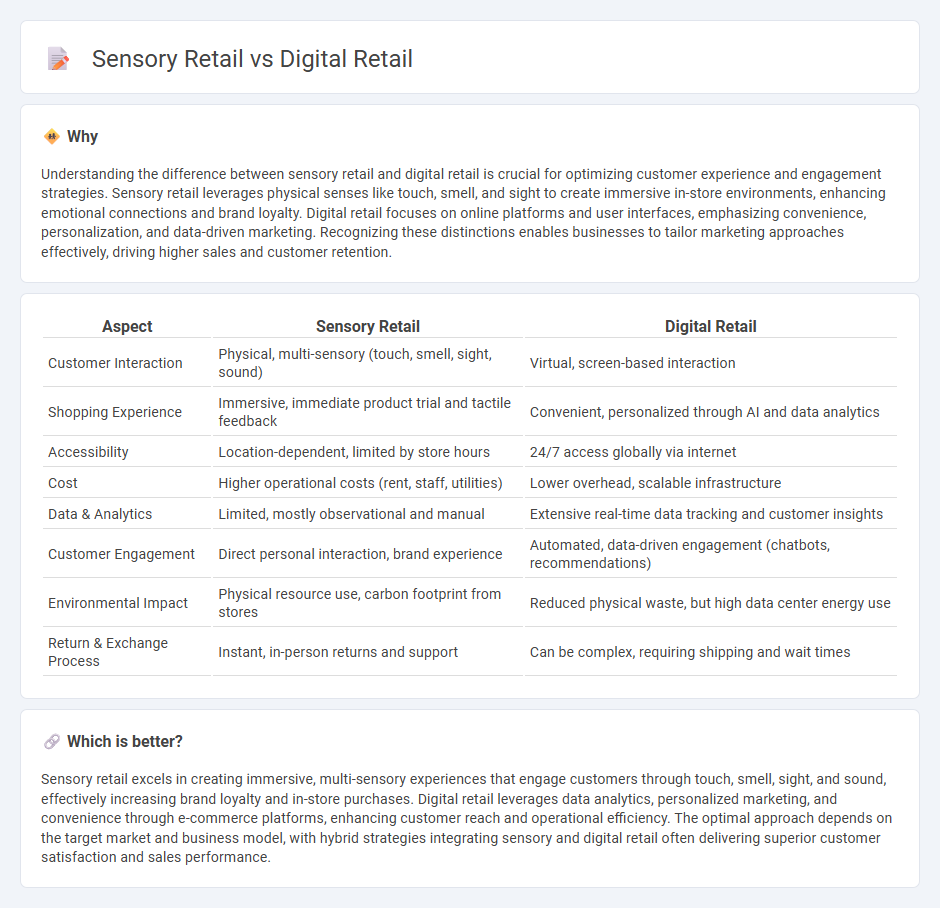
Sensory retail leverages physical store environments to engage customers through sight, sound, smell, touch, and taste, creating immersive brand experiences that stimulate emotional connections and drive purchases. Digital retail utilizes online platforms and data analytics to offer personalized shopping experiences, convenience, and seamless transactions across multiple channels. Explore how integrating sensory and digital retail strategies can revolutionize customer engagement and boost sales.
Why it is important
Understanding the difference between sensory retail and digital retail is crucial for optimizing customer experience and engagement strategies. Sensory retail leverages physical senses like touch, smell, and sight to create immersive in-store environments, enhancing emotional connections and brand loyalty. Digital retail focuses on online platforms and user interfaces, emphasizing convenience, personalization, and data-driven marketing. Recognizing these distinctions enables businesses to tailor marketing approaches effectively, driving higher sales and customer retention.
Comparison Table
| Aspect | Sensory Retail | Digital Retail |
|---|---|---|
| Customer Interaction | Physical, multi-sensory (touch, smell, sight, sound) | Virtual, screen-based interaction |
| Shopping Experience | Immersive, immediate product trial and tactile feedback | Convenient, personalized through AI and data analytics |
| Accessibility | Location-dependent, limited by store hours | 24/7 access globally via internet |
| Cost | Higher operational costs (rent, staff, utilities) | Lower overhead, scalable infrastructure |
| Data & Analytics | Limited, mostly observational and manual | Extensive real-time data tracking and customer insights |
| Customer Engagement | Direct personal interaction, brand experience | Automated, data-driven engagement (chatbots, recommendations) |
| Environmental Impact | Physical resource use, carbon footprint from stores | Reduced physical waste, but high data center energy use |
| Return & Exchange Process | Instant, in-person returns and support | Can be complex, requiring shipping and wait times |
Which is better?
Sensory retail excels in creating immersive, multi-sensory experiences that engage customers through touch, smell, sight, and sound, effectively increasing brand loyalty and in-store purchases. Digital retail leverages data analytics, personalized marketing, and convenience through e-commerce platforms, enhancing customer reach and operational efficiency. The optimal approach depends on the target market and business model, with hybrid strategies integrating sensory and digital retail often delivering superior customer satisfaction and sales performance.
Connection
Sensory retail enhances the digital retail experience by integrating multisensory elements such as visuals, sounds, and tactile feedback into online platforms, creating immersive and engaging shopping environments. Technologies like augmented reality (AR) and virtual reality (VR) enable customers to interact with products virtually, bridging the gap between physical and digital retail spaces. This fusion of sensory stimuli and digital tools drives higher customer engagement, satisfaction, and conversion rates in the evolving retail landscape.
Key Terms
Omnichannel
Digital retail leverages e-commerce platforms, mobile apps, and data analytics to provide personalized and seamless shopping experiences across multiple online channels. Sensory retail enhances physical store environments through engaging sight, sound, smell, and touch elements to create memorable and immersive customer interactions. Exploring the integration of omnichannel strategies reveals how combining digital convenience with sensory engagement drives customer loyalty and sales growth; discover more about optimizing your retail approach.
Experiential Design
Digital retail leverages interactive technologies, augmented reality, and personalized algorithms to create immersive online shopping experiences that engage customers beyond traditional browsing. Sensory retail emphasizes multi-sensory elements such as tactile displays, ambient scents, and auditory cues to enhance physical store environments, fostering emotional connections and memorable brand interactions through experiential design. Discover how integrating digital innovation with sensory engagement can transform retail spaces and elevate consumer experiences.
Phygital
Phygital retail seamlessly integrates digital technology with sensory experiences to enhance customer engagement and drive sales. By combining in-store sensory stimuli such as touch, smell, and sight with advanced digital tools like augmented reality, personalized apps, and interactive displays, Phygital creates a more immersive shopping environment than traditional digital retail. Explore how Phygital innovations are transforming retail strategies and customer experiences for valuable insights.
Source and External Links
What Is Digital Retail? (Examples & Tools) (2024) - Digital retail integrates a business's digital presence including online and offline experiences, illustrated by brands using augmented reality, unified POS systems, and omnichannel strategies to enhance customer satisfaction and sales growth.
What is Retail Digital Transformation? - Retail digital transformation embeds technology into operations to improve customer experience, loyalty, sales, and efficiency by offering personalized services and omnichannel shopping options.
Automotive Digital Retailing - Digital retailing in automotive modernizes buying with omnichannel platforms delivering seamless online and showroom transactions, increasing engagement, deal efficiency, and customer satisfaction.
 dowidth.com
dowidth.com